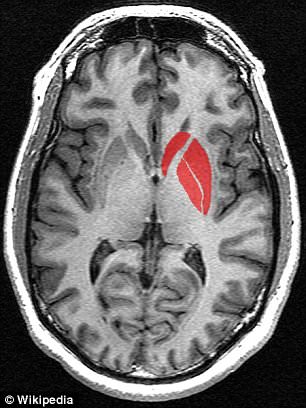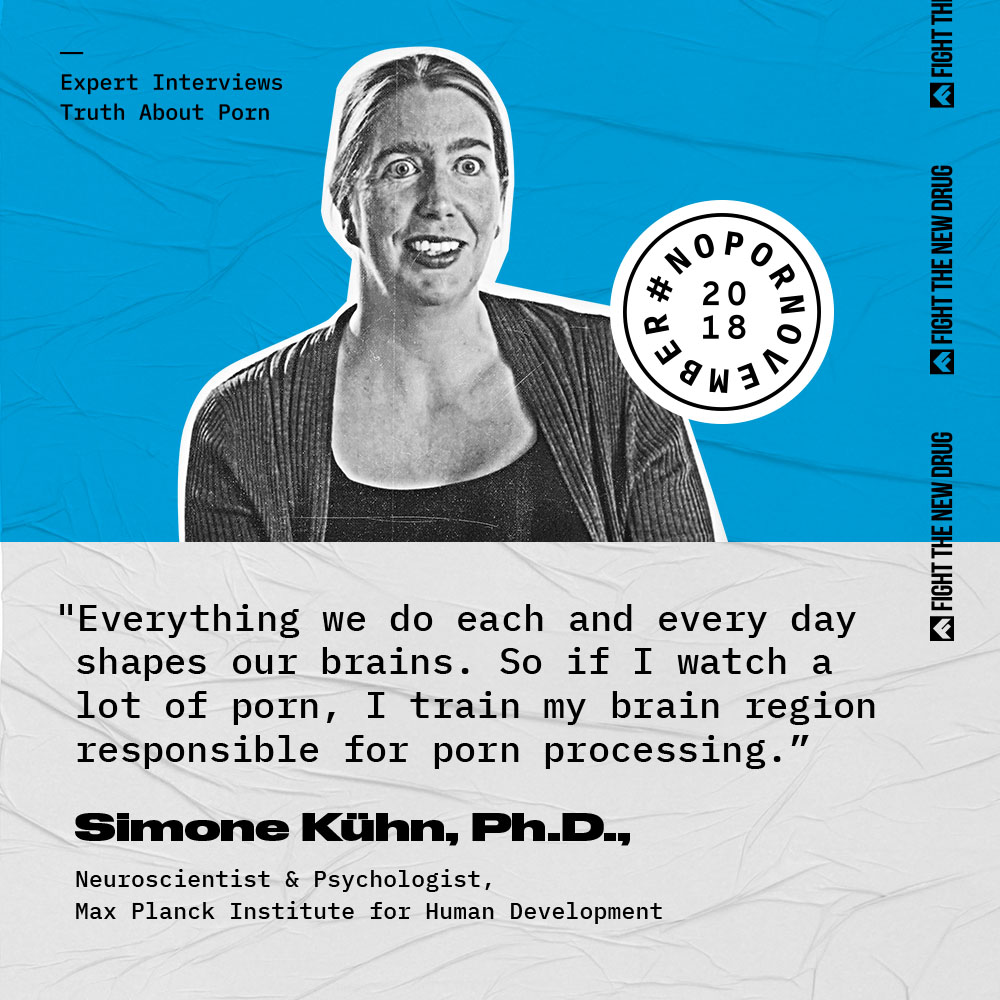Since porn first appeared on the internet only a few decades ago, the accessibility, affordability, and anonymity of consuming addictive and explicit images have increased and attracted millions and millions of users.
Based on the assumption that pornography consumption bears resemblance with reward-seeking behavior, novelty-seeking behavior, and addictive behavior, a group of scientists hypothesized that frequent porn consumers’ brains would look different from the average person.
And they were right.
In our brand new, three-part documentary series, Brain, Heart, World, we interview the study author, Simone Kühn, Ph.D., Neuroscientist and Psychologist at the Max Planck Institute for Human Development in Berlin. Check out the first episode, “The Brain,” right here:
The study
German researchers recruited 64 men between the ages of 21 and 45 who watched an average of four hours of porn per week. The researchers did MRI scans of men’s brains while showing them a mixture of sexually explicit images and non-sexual imagery. Here’s what they found.
“Our findings indicated that gray matter volume of the right caudate of the striatum is smaller with higher pornography use,” the researchers wrote in the journal article, referring to an area of the brain associated with reward processing and motivation. Men who watched more porn also showed less activity in another area of the striatum, called the left putamen, which usually lights up in response to sexual images.
Their research was published just a couple of years ago in the journal JAMA Psychiatry, so check it out.
Related: Research Suggests Porn Linked To Brain Structure Changes
The study also showed heavy porn consumers also had a weaker connection between the striatum and the prefrontal cortex, an area of the brain associated with decision-making, reports The Huffington Post.

The striatum (shown in red), which is linked to motivation, was smaller the more porn consumption the participants reported.
“Dysfunction of this circuitry has been related to inappropriate behavioral choices, such as drug seeking, regardless of the potential negative outcome,” the researchers wrote in the article.
Yikes. So does that mean that porn has the power to really shrink consumers’ brains? Not necessarily, the researchers say.
Chicken or the egg?
“It’s not clear, for example, whether watching porn leads to brain changes or whether people born with certain brain types watch more porn,” study author Dr. Kühn told Reuters in an email.
Related: How Porn Changes The Brain
Kuhn and her colleagues said they hoped future studies would reveal how “excessive porn consumption” may affect the brain over time, and how it affects the brains of new consumers.
Check out this video from our friends at Truth About Porn of Dr. Kühn explaining their findings:
More backed-up proof
While Dr. Kühn and her team were some of the first to conduct this study with these results, they weren’t the last.
In a study published in April 2016, in the The Journal of Sexual Medicine, researchers also used MRI scans and also found decreased connections between the ventral striatum and prefrontal cortex in the compulsive sexual behavior group versus the control group.
Also, just last year, researchers from the Department of Psychiatry at the University of Cambridge led by Dr. Valerie Voon recently found similar results in 2017. In this study, the compulsive sexual behavior participants again showed a reduced level of connectivity between the left amygdala and the dorsolateral prefrontal cortex, an area of the brain which is heavily implemented in inhibitory control. Interestingly, this area of the brain is known to have a long maturation period that stretches into adulthood, and it may be particularly susceptible to disruption during maturing years in adolescence.
In case you’re keeping score, now there is a total of 13 out of 38 neurological studies (including fMRI, Neuropsych, EEG) on compulsive or addicted porn consumers have reported altered prefrontal cortex activity or poorer executive functioning (also known as “hypofrontality”). Check out the research for yourself, by clicking here.
Why this matters
Porn is sold as “harmless” entertainment that has no effect on consumers or our society, but science and research are constantly proving that wrong. And even if you aren’t part of the group who, like in the study, consume four hours of porn or more a week, a “casual” habit can still have some serious negative effects like contributing to sex trafficking and sexual exploitation.
Just like it took decades for society to believe the science that proved that smoking cigarettes was harmful, we are learning a similar lesson with porn in our world today. And since we’re an awareness campaign, first and foremost, we’re all about getting these facts into the light.
With all this new information gathered from research and scientific studies, it is time for society to accept that pornography is harmful. Science and research are showing us how porn harms the brain, damages relationships, and negatively affects society as a whole. We’re on the cutting edge of science, and there are sure to be further studies about porn and consumers’ brains. Until then, check out these facts.
Bottom line:
Get Involved
Porn is anything but harmless, and we’re educating society on the facts. Take a stand and share this post and shine a light on the brain changes linked to frequent porn consumption.
Spark Conversations
This movement is all about changing the conversation about pornography and stopping the demand for sexual exploitation. When you rep a tee, you can spark meaningful conversation on porn’s harms and inspire lasting change in individuals’ lives, and our world. Are you in? Check out all our styles in our online store, or click below to shop:
Your Support Matters Now More Than Ever
Most kids today are exposed to porn by the age of 12. By the time they’re teenagers, 75% of boys and 70% of girls have already viewed itRobb, M.B., & Mann, S. (2023). Teens and pornography. San Francisco, CA: Common Sense.Copy —often before they’ve had a single healthy conversation about it.
Even more concerning: over half of boys and nearly 40% of girls believe porn is a realistic depiction of sexMartellozzo, E., Monaghan, A., Adler, J. R., Davidson, J., Leyva, R., & Horvath, M. A. H. (2016). “I wasn’t sure it was normal to watch it”: A quantitative and qualitative examination of the impact of online pornography on the values, attitudes, beliefs and behaviours of children and young people. Middlesex University, NSPCC, & Office of the Children’s Commissioner.Copy . And among teens who have seen porn, more than 79% of teens use it to learn how to have sexRobb, M.B., & Mann, S. (2023). Teens and pornography. San Francisco, CA: Common Sense.Copy . That means millions of young people are getting sex ed from violent, degrading content, which becomes their baseline understanding of intimacy. Out of the most popular porn, 33%-88% of videos contain physical aggression and nonconsensual violence-related themesFritz, N., Malic, V., Paul, B., & Zhou, Y. (2020). A descriptive analysis of the types, targets, and relative frequency of aggression in mainstream pornography. Archives of Sexual Behavior, 49(8), 3041-3053. doi:10.1007/s10508-020-01773-0Copy Bridges et al., 2010, “Aggression and Sexual Behavior in Best-Selling Pornography Videos: A Content Analysis,” Violence Against Women.Copy .
From increasing rates of loneliness, depression, and self-doubt, to distorted views of sex, reduced relationship satisfaction, and riskier sexual behavior among teens, porn is impacting individuals, relationships, and society worldwideFight the New Drug. (2024, May). Get the Facts (Series of web articles). Fight the New Drug.Copy .
This is why Fight the New Drug exists—but we can’t do it without you.
Your donation directly fuels the creation of new educational resources, including our awareness-raising videos, podcasts, research-driven articles, engaging school presentations, and digital tools that reach youth where they are: online and in school. It equips individuals, parents, educators, and youth with trustworthy resources to start the conversation.
Will you join us? We’re grateful for whatever you can give—but a recurring donation makes the biggest difference. Every dollar directly supports our vital work, and every individual we reach decreases sexual exploitation. Let’s fight for real love:



